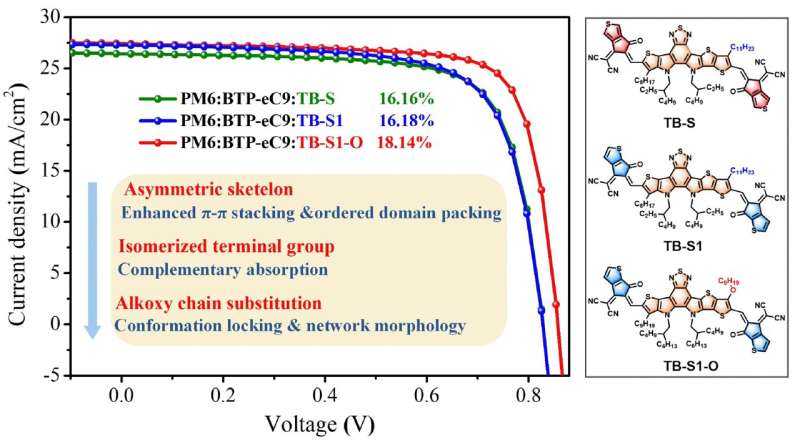Chemical structures of TB-S, TB-S1, TB-S1-O, and J-V curves of their ternary organic solar cells. Credit: NIMTE
A research group led by Prof. Ge Ziyi at the Ningbo Institute of Materials Technology and Engineering (NIMTE) of the Chinese Academy of Sciences (CAS) has developed an alkoxy-substituted asymmetric conjugated molecule and doped it into the PM6:BTP-eC9-based binary organic solar cells (OSCs) as a third component, resulting in high-efficiency ternary OSCs with a power conversion efficiency (PCE) of over 18.1%.
This work was published in ACS Energy Letters.
OSCs have attracted a lot of attention in the clean solar energy field because of their solution processability, transparency, portability, and flexibility. The ternary strategy is widely recognized as a facile and efficient way to improve OSCs performance.
However, to date, the "structure-performance" correlation of ternary device has rarely been thoroughly and systematically elucidated. Therefore, there is an urgent need to uncover the correlation between molecular structure, active layer morphology and photovoltaic performance to provide effective strategies for achieving high-performance OSCs.
To address this issue, the researchers synthesized three asymmetric skeleton non-fullerene acceptors, i.e., TB-S, TB-S1, and TB-S1-O, and employed them as the third component in the host binary system of PM6:BTP-eC9, respectively.
Benefiting from the additional noncovalent conformation lock, the alkoxy-substituted TB-S1-O possessed a wide band gap, stable planar conformation, high surface energy, excellent compatibility with the host materials, and a large ordered stacking domain, which shows superior performances than TB-S, TB-S1.
Notably, the PM6:BTP-eC9:TB-S1-O ternary film possesses an ideal interpenetrating network, contributing to a reduction in nonradiative voltage loss and an enhancement in charge transport. Consequently, when the researchers blended TB-S1-O into the PM6:BTP-eC9 system, a significant increase of PCE from 17.36% of binary film to 18.14% of ternary film was demonstrated.
Due to the inferior morphology, the devices based on PM6:BTP-eC9:TB-S and PM6:BTP-eC9:TB-S1 show a remarkably lower PCE (i.e., 16.16% and 16.18%, respectively), in comparison with the PM6:BTP-eC9:TB-S1-O based ternary device.
This work demonstrates that asymmetric skeleton with alkoxy-substitution is an efficient strategy to construct the third component for high-performance ternary OSCs.
More information: Lin Xie et al, Alkoxy Substitution on Asymmetric Conjugated Molecule Enabling over 18% Efficiency in Ternary Organic Solar Cells by Reducing Nonradiative Voltage Loss, ACS Energy Letters (2022). DOI: 10.1021/acsenergylett.2c02201
Journal information: ACS Energy Letters
Provided by Chinese Academy of Sciences
























